

Verbal Judo and Tactical Communication
Nov 18, 2014
1.11k likes | 3.72k Views
Verbal Judo and Tactical Communication. Introduction. Deputy Nathan Green Currently employed with the Jefferson County Sheriff’s Office. United States Army 1996-2000. Hanover Collage Security EMT 2003-2006. Jefferson County Sheriff’s Department. 2006 to present Education
Share Presentation
- verbal judo
- tactical communication
- answers compliance
- generating voluntary cooperation
- united states army basic

Presentation Transcript
Verbal Judo andTactical Communication
Introduction • Deputy Nathan Green • Currently employed with the Jefferson County Sheriff’s Office. • United States Army 1996-2000. • Hanover Collage Security EMT 2003-2006. • Jefferson County Sheriff’s Department. 2006 to present • Education • Graduate of Southwestern High School 1991 • United States Army Basic and AIT • Campus Police and EMT Hanover Collage • Indiana Law Enforcement Academy class 170
Objectives • Define Verbal Judo. • List the 3 C’s of the GVC. • Explain the L.E.A.P.S concept. • List 4 of the 11 things never to say to anyone.
A little Verbal + Judo four horseman of the apocalypse.
Definition #1 • Tactical communication training that enables officers to further preserve law and order while maintaining their own and the public’s safety by using appropriate presence and words as force options.
Definition #2 • Verbal Judo is an established method of providing law enforcement officers with proper communication skills to help them in their day to day activities.
Definitions #3 & 4 • Using one’s words to prevent, de-escalate, or end an attempted assault. • Defined as a way of using words to maintain mental and emotional safety.
Need for Verbal Judo • In any of these definitions it is agreed that verbal judo is a necessary means of enforcing personal boundaries and limits. • The redirection of a person’s behavior with words is a law enforcement officer’s most important weapon for keeping him/herself and the public safe. • Speech is power. Power to persuade, convert and to compel (Emerson)
The concepts of the GVC • Keys to Generating Voluntary Compliance • Compliance • Keys to Generative Voluntary Cooperation • Cooperation • Collaboration
Keys to Generating Voluntary Compliance
Compliance • Defined: The action of complying with a wish or command. • The tone of your voice when you first speak with someone will set the stage of your interaction. • The expression on your face will also aid in the ongoing interaction. • Body language is also an important component of the first impression to gain compliance.
Keys to Generating Voluntary Cooperation
Cooperation • Defined: The process of working together to the same end. • The words you use in your initial conversation with your subject can and will lead to cooperation if done correctly. • Ask, don’t tell. Adults don’t like to be told what to do. Avoid making others defensive. • If you are not open and professional, getting people to convert to your way of thinking is nearly impossible.
Collaboration • Defined: The action of working with someone to produce or create something. • Motivation is essential to collaboration. • Displaying a willingness to help others can open a door to collaboration • Improve your aptitude for listening to the viewpoints of others.
L.E.A.P.S • A basic tool for generating the three C’s • L. Listen • E. Empathize • A. Ask • P. Paraphrase • S. Summarize
Listen • Listening is not a natural act. • It is highly artificial and artistic. • In fact, listening is not the opposite of talking. • In our culture, the opposite of talking is more like waiting to interrupt. (G.J Thompson Ph.D)
Steps of Active Listening • Being open and unbiased. • Hearing literally. • Interpreting the data. • Acting on the data.
Empathize • You don’t have to agree; just try and understand where the person is coming from. • If a person believes in you, in your service to them, in your desire to help often times that is enough to generate voluntary compliance. • If you can show someone that what you are doing is ultimately going to benefit them there is a good chance that you can win them over.
Ask • Who, what, when, where, why, and how? • This allows your subject to choose his answer and lets them feel in control. • Opinion seeking • How do you think this should be handled? • This is very powerful type of question because it allows you’re subject to state his opinion.
Ask (continued) • Direct. Yes or No? • These can be useful in their own right but too many in a row can be counterproductive. • Leading. Isn’t it true that? • This type of question should be used with a number of other methods. • Jumping directly into leading questions will have a chance to anger people do to the fact you are essentially putting words in someone’s mouth.
Paraphrase • When your subject explains his problem repeat the problem back, even if you don’t understand it. • Even if you don’t care about your subject’s problem you should still appear to care by explaining the problem back to them.
Summarize • Be brief. • Be concise. • Be inarguable
Things never to say to anyone • Come here! • You wouldn’t understand. • Because those are the rules. • It’s none of your business. • What do you want me to do about it? • Calm Down. • What’s your problem? • You never or you always. • I’m not going to say this again. • I’m doing this for your own good. • Why don’t you be reasonable?
Come here! • This command actually means run away to some people. • It is a vaguely threatening statement. • Try saying excuse me and see what happens.
You wouldn’t understand. • You might as well put a comma and then stupid at the end. • If you are being pressed to reveal something try I am not willing to answer that right now.
Because those are the rules. • That comes across as kind of insensitive. • Understand the rules and regulations so you can impart knowledge when you are asked the hard questions.
It’s none of your business. • This phrase can anger people because it cuts them off. • Just explain why you cannot tell them.
What do you want me to do about it? • This statement can be a cop-out that affects you credibility. • Just explain that you are sorry. You don’t have the answer they are looking for.
Calm Down. • This is basically a criticism of one’s behavior. • Tell them it’s going to be ok, you are there to help.
What’s your problem? • This is a you versus me comment • Try what’s the matter or how can I help?
You never or you always. • This statement is a lie. • Try something like I know it seems that way but what can I do to help.
I’m not going to say this again. • Stay away from this trap of a statement. • Try something like I need you to understand the say let me say it again, and please listen carefully.
I’m doing this for your own good. • No one believes this statement. • If it really is for the persons own good you better be able to explain why.
Why don’t you be reasonable? • This question can invite conflict. • Try being reasonable with them. Let me see if I understand your position.
Summary • This block if instruction will help the student with the concepts of verbal judo and how it relates to police work. We will examine the basic techniques of verbal judo. How to best accomplish ones goal in the application of verbal judo and the importance that verbal judo can play when used in the police
Objectives • Define verbal judo. • List the 3 C’s of the GVC. • Explain the L.E.A.P.S concept. • List 4 of the 11 never to say to anyone.
Test questions • Name the three C’s of the GVC? • Answers: Compliance, Cooperation, Collaboration • Explain the L in Leaps? • Answer: Listen. • Explain in your own words the use for Verbal Judo in police work? • Essay: Verbal Judo is an established method of providing law enforcement officers with proper communication skills to help them in their day to day activities.
- More by User

Verbal Judo
Verbal Judo. Customer Care for Difficult People Presented by Mellonie Richardson . What is Verbal Judo?. Verbal : Of, relating to, or associated with words: a detailed verbal description. Judo :
1.91k views • 13 slides
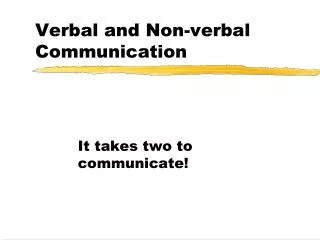
Verbal and Non-verbal Communication
Verbal and Non-verbal Communication. It takes two to communicate!. Four Elements of Communication. Sender -generates information, thoughts, ideas or feelings Message - generated by sender and responded to by receiver. Four Elements of Communication.
2.64k views • 28 slides
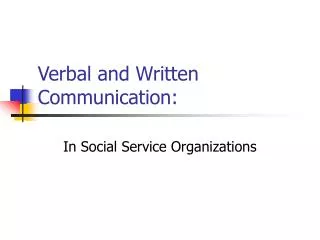
Verbal and Written Communication:
Verbal and Written Communication:. In Social Service Organizations. Styles of Written Communication Vary. In writing organization documents: . Know who your audience is (supervisor, staff members, clients, public, funders, politicians). Keep the message simple.
578 views • 13 slides

Verbal Judo. Redirecting Behavior with Words. Means…. Ju : Gentle or soft Do: Way. First Principle. Move confrontations away from conclusions back to the reasoning point.
1.21k views • 20 slides
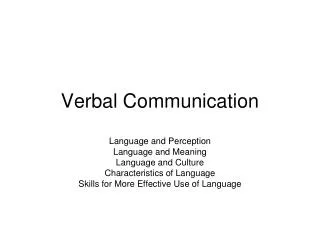
Verbal Communication
Verbal Communication. Language and Perception Language and Meaning Language and Culture Characteristics of Language Skills for More Effective Use of Language. Language has Power!. Quick Definitions.
7.85k views • 12 slides

Verbal and non-Verbal Communication
Verbal and non-Verbal Communication. “Verbal Communication.”. We may often think that, having good communication skills is all about the ability to speak well….. Or all about “SPEAKING.”. We are right……. But only 50% right. Because….
2.02k views • 52 slides


VERBAL AND NON VERBAL COMMUNICATION
VERBAL AND NON VERBAL COMMUNICATION. 7 Cs. 1. Completeness 2. Conciseness 3. Consideration 4. Concreteness 5. Clarity 6. Courtesy 7. Correctness. 1.COMPLETENESS. Business message is complete when it contains all facts the reader or listener needs for the reaction you desire.
1.11k views • 38 slides

Verbal and Non-Verbal Communication
Verbal and Non-Verbal Communication. When you are finished the quiz, Open your textbooks and turn to page 187. Complete reading 12 Communication. When you are finished with the reading, create a T-chart which shows all the different ways we communicate verbally and non-verbally.
3.15k views • 11 slides

Verbal Communication. Health Science. Rationale. Expertise in communication skills is necessary for workers in health care. To deliver quality health care, the health care provider must be an effective communicator. Objectives. Upon completion of this lesson, the student will be able to:
1.18k views • 27 slides

3. Verbal Communication. Language. A body of symbols and the systems for their use in messages that are common to the people of the same speech community Speech community Words Sapir-Whorf hypothesis. Uses of Language. To designate, label, define, and limit To evaluate
544 views • 11 slides
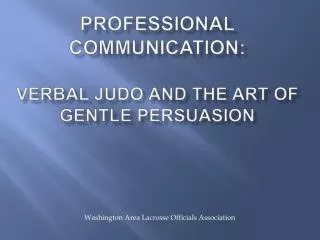
Professional Communication: Verbal Judo and The Art of Gentle Persuasion
Professional Communication: Verbal Judo and The Art of Gentle Persuasion. Washington Area Lacrosse Officials Association. The Truth about Customers. The customer isn’t always right. But they are always the customer. What We Provide as Officials:. Safety Direct Customer Contact
751 views • 28 slides

Verbal Communication. Interviewing. Categories of Verbal Communication. Advantages of Verbal Communications. Can be directed to a specific and correct audience You get an instant response or action You can control a situation and provide feedback Can address a single or multiple audience
621 views • 6 slides

Verbal Communication. Communication. Communication: process of conveying information in such a way that the message is received and understood. You can share ideas, opinions, and facts with others Good communication is a skill you will use throughout your life. Communciation.
999 views • 19 slides
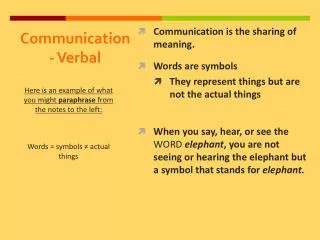
Communication - Verbal
Communication is the sharing of meaning. Words are symbols They represent things but are not the actual things When you say, hear, or see the WORD elephant , you are not seeing or hearing the elephant but a symbol that stands for elephant. Communication - Verbal.
396 views • 12 slides
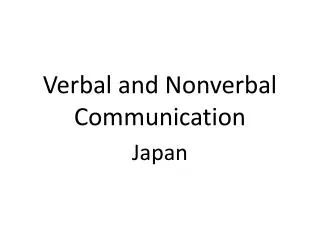
Verbal and Nonverbal Communication
Verbal and Nonverbal Communication . Japan. Nonverbal Communication . Shaking Hands The act of bowing Eye Contact. Nonverbal Communication . Displays of Emotion Fear Anger Exuberance. Business Card Exchange Appropriate exchange. Nonverbal Communication .
667 views • 6 slides

Verbal Communication. CHAPTER TOPICS. Language is Symbolic Understandings and Misunderstandings The Impact of Language Gender and Language Culture and Language. Language is Symbolic. Cat. Symbol- word Referent- thing Reference- meaning. Understanding and Misunderstanding.
783 views • 12 slides

VERBAL JUDO
VERBAL JUDO. The Gentle Art of Persuasion George J. Thompson, Ph.D Jerry B. Jenkins Presented by Mark Dreibelbis, Assistant Commissioner, NCHSAA NFHS Annual Meeting 2011 – Philadelphia. Handling the Attacks. You will be attacked – little question of that.
1.89k views • 33 slides

Verbal communication
Oral Communication Written Communication. Verbal communication. Oral communication implies communication through mouth. It is recommended when the communication matter is of temporary kind or where a direct interaction is required. It is significant so as to build a rapport and trust.
1.56k views • 13 slides

Verbal and Non Verbal Communication
Here is an outline of what is verbal and non-verbal communication, and how to improve it in most effective way. https://www.aksent.org.in/courses/communicative-english/
652 views • 10 slides

Verbal and Non Verbal Communication.
1.75k views • 22 slides

Verbal Communication. Chapter 3. Verbal Communication. Talking and eloquence are not the same: to speak and to speak well are two things. A fool may talk, but a wise speaks. — Ben Jonson
1.02k views • 51 slides

verbal communication, definition, types, characteristics and conclusion
742 views • 9 slides

IMAGES